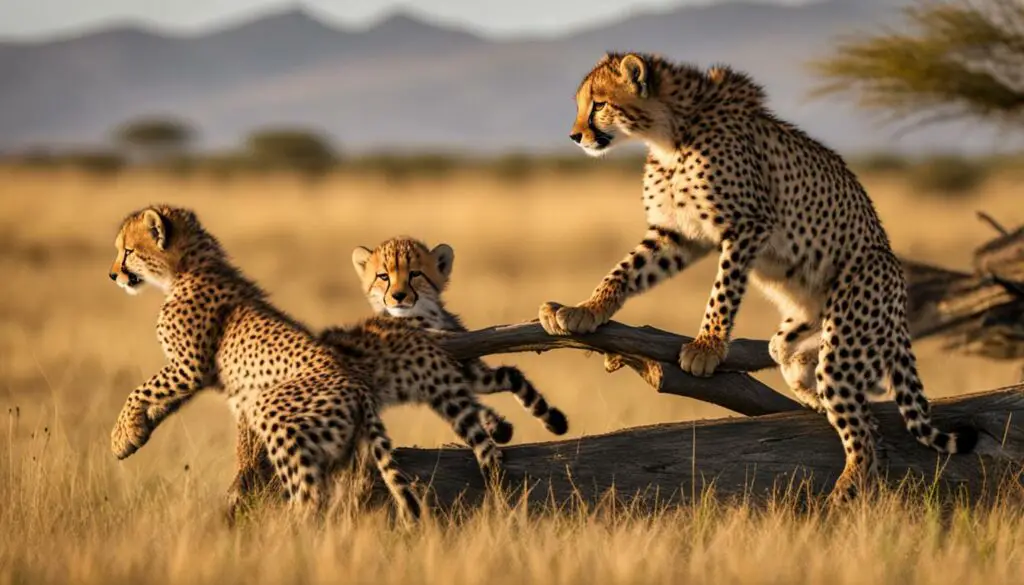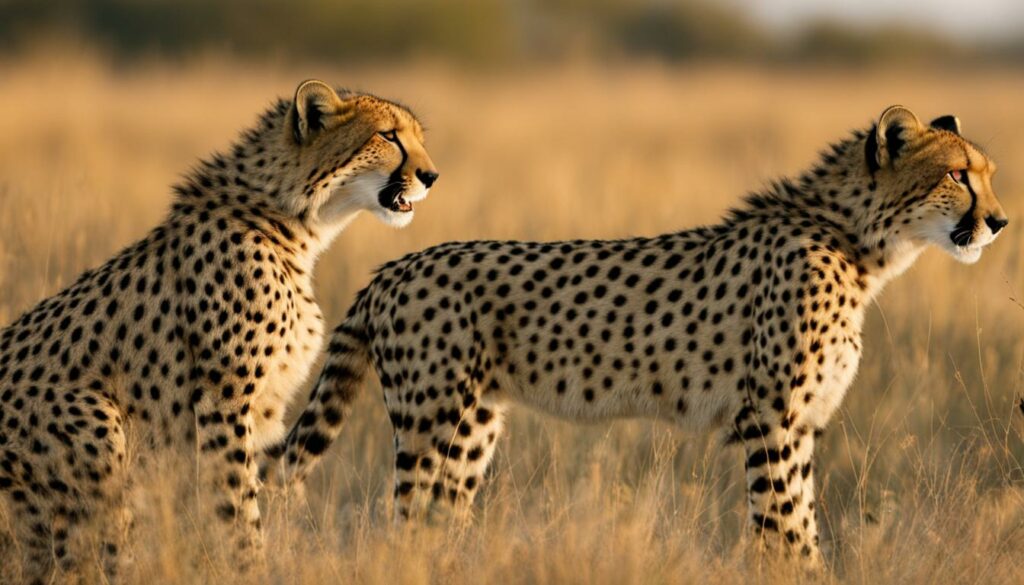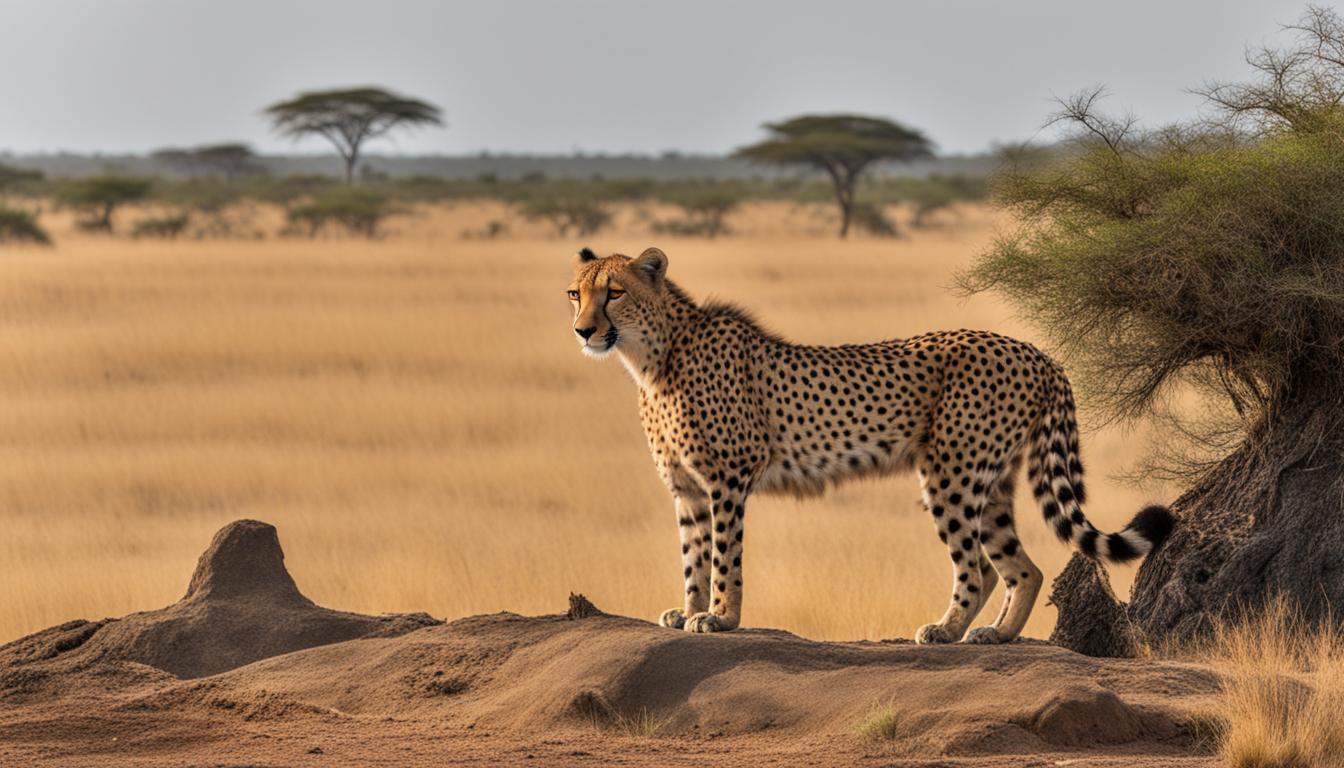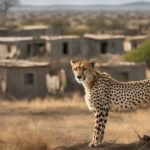Welcome to our article on cheetahs! In this section, we will explore how cheetahs establish and defend their territories. Cheetah territory, cheetah habitats, and cheetah conservation are all crucial aspects of understanding these magnificent creatures.
Cheetahs, as adult individuals, establish their territories either alone or in coalitions. Coalitions are formed by two to three male litter mates who work together to defend their territory against other males. In the Serengeti, female cheetahs may roam in an area of approximately 829 square km.
Cheetahs are territorial animals and rarely leave their area of residency, except when seeking mating partners. The threats they face, such as habitat loss and declining prey numbers, emphasize the importance of conservation efforts to protect their territories.
The Behavior of Cheetahs
Cheetahs have unique behavioral characteristics that set them apart from other big cats. They exhibit both solitary and group behavior, with adult females typically living alone and males forming coalitions to defend their territories. These coalitions are usually composed of related litter mates who spend a significant amount of time together, even grooming each other. In contrast, non-territorial males, often adolescents, are nomadic and can cover large areas in search of suitable territories.
Cheetahs are territorial animals and rarely leave their area of residency, except when seeking mating partners. However, solitary males rarely hold onto territories when faced with the presence of a coalition. These magnificent creatures are known to communicate through various vocalizations, including calls and yips, especially when they become separated from one another.
“Cheetahs exhibit both solitary and group behavior, with males forming coalitions to defend their territories.”
The behavior of cheetahs highlights their adaptability and social dynamics. While females establish large territories and fiercely defend them against intruding females, male territories often overlap with those of females. This overlapping allows for potential interaction and mating opportunities.
| Behavioral Traits | Description |
|---|---|
| Solitary Behavior | Adult females primarily live alone and defend large territories. |
| Coalition Behavior | Males often form coalitions with related littermates to protect smaller territories. |
| Nomadic Behavior | Non-territorial males, usually adolescents, roam over larger areas searching for suitable territories. |
| Vocalizations | Cheetahs communicate through various vocalizations, including calls and yips. |
| Territorial Dynamics | Female territories are larger and defended against intruding females, while male territories often overlap with female territories. |
The behavioral patterns of cheetahs contribute to their survival in the wild. Maintaining territories allows them to establish a stable hunting ground and increase their chances of finding suitable mates. Understanding the behavior of these incredible animals is crucial for conservation efforts and the long-term survival of cheetah populations.
The Appearance and Build of Cheetahs
Cheetahs are renowned for their striking appearance and unique physical adaptations that make them exceptional hunters in the African savannah. Their appearance is characterized by a tan or buff-colored coat adorned with solid black spots evenly spaced across their bodies. These distinctive spots provide effective camouflage, blending with the surrounding grasses and shrubs, allowing cheetahs to remain undetected by their prey. Additionally, cheetahs have distinct tear-shaped lines on each side of their nose, accentuating their facial features.
When compared to females, male cheetahs are slightly larger in size and have a more robust build. They possess a bigger head, which houses powerful jaw muscles necessary for capturing and killing their prey. Cheetahs are built for speed, with a slender, aerodynamic body and long limbs. Their adaptations for speed include a powerful heart, large arteries that provide oxygenated blood to their muscles, and a highly flexible spine that enables their bodies to stretch during high-speed pursuits.
Cheetahs’ physical attributes extend to their claws, which are short and blunt. Unlike other big cats, cheetahs cannot retract their claws fully. This unique feature provides them with greater traction when running at high speeds, similar to the spikes on a sprinter’s shoes. These specialized claws, combined with their muscular hind legs, enable cheetahs to generate incredible acceleration, reaching speeds of up to 70 miles per hour in just a few seconds.
| Physical Traits | Adaptations |
|---|---|
| Tan or buff-colored coat with black spots | Effective camouflage in the African savannah |
| Tear-shaped lines on each side of the nose | Enhances facial features and visual appeal |
| Males slightly larger with a bigger head | Possess powerful jaw muscles for capturing prey |
| Slender, aerodynamic body and long limbs | Optimized for high-speed pursuits |
| Short, blunt claws | Provide traction and stability during high-speed runs |
| Powerful heart and large arteries | Facilitate efficient oxygen transport to muscles |
The cheetah’s sleek and aerodynamic physique, along with its powerful heart and flexible spine, enable it to outrun and outmaneuver its prey in the unforgiving African grasslands.
In summary, cheetahs possess a unique and awe-inspiring appearance, equipped with physical adaptations that enhance their hunting prowess and enable them to thrive in their natural habitat. Their tan coat with black spots provides effective camouflage, while their tear-shaped lines and distinctive facial features give them a truly striking appearance. With their slender bodies, long limbs, and powerful heart, cheetahs are perfectly designed for high-speed pursuits, reaching incredible speeds in short bursts to secure their prey.
Cheetah Cubs and Family Life
When it comes to cheetah family life, the cubs play a crucial role. Cheetah cubs are born with dark fur and blended spots, providing them with camouflage in their early months. As they grow, their coat transitions to a yellowish-gray color known as a mantle. This coloration helps them blend into their surroundings and increases their chances of survival.
Female cheetahs, also known as mothers or dams, tend to live alone, except when they are raising cubs. Male cheetahs, on the other hand, often form coalitions with their siblings and stay together for life. These coalitions provide protection and support for the males, increasing their chances of successfully defending their territories against rival males.
Female cheetahs establish large territories and fiercely defend them against intruding females. Male territories, on the other hand, often overlap with female territories. This overlapping of territories creates a unique dynamic within cheetah society, allowing for interaction and potential mating opportunities. However, it also introduces competition between males for access to females.
| Aspect | Details |
|---|---|
| Cooperative Behavior | Male siblings often form coalitions and stay together for life, providing support and protection |
| Female Territories | Establish large territories and fiercely defend them against other females |
| Male Territories | Often overlap with female territories, creating opportunities for interaction |
Cheetah territories are not static and can change over time, especially during periods of drought when prey is scarce. During these challenging times, cheetahs may need to move to find food and water, often following their prey. This adaptive behavior ensures they can survive in their ever-changing environments and maintain the boundaries of their territories.

Cheetah Cubs: A Vulnerable Time
The period of cheetah cubhood is particularly vulnerable for these young predators. They rely completely on their mother for food, protection, and guidance. Female cheetahs are dedicated mothers, nurturing and caring for their cubs until they are old enough to fend for themselves.
During this time, the female cheetah teaches her cubs essential hunting skills, such as stalking, sprinting, and capturing prey. She demonstrates proper techniques and provides opportunities for the cubs to practice these skills under her guidance. This period of learning is crucial for the cubs’ development and prepares them for an independent life in the wild.
Overall, the family life of cheetahs revolves around the care and protection of the cubs. It is through the guidance of their mothers and the support of their coalition mates that cheetahs navigate their way through the challenges of their territories, ensuring the survival and success of this magnificent species.
Social Behavior and Communication
Cheetahs exhibit unique social behaviors and communication patterns that contribute to their survival and territorial dynamics. Understanding these aspects of cheetah behavior is essential in protecting their habitats and supporting conservation efforts.
Social Interactions
Cheetahs are not highly social animals compared to other large cats, but they still engage in various forms of social interaction. These interactions are particularly evident during mating, raising cubs, and coalition formation. Males often form lifelong coalitions with their littermates, which helps them defend territories against other males. This cooperative behavior facilitates increased hunting success and territory protection.
When cheetahs encounter familiar individuals, they engage in behaviors similar to dogs. They sniff, lick, and rub cheeks as a way of greeting and establishing social bonds. This social grooming helps maintain relationships within coalitions and reinforces their territorial connections.
Communication Methods
Cheetahs utilize a variety of vocalizations and body language to communicate with one another. While they do not roar like other big cats, they can purr, chirp, and produce distinct barking sounds. These vocalizations serve different purposes, such as contact calls to locate one another or territorial calls to warn intruders.
“Cheetahs are not known for roaring like other large cats, but they can purr.”
Another crucial means of communication for cheetahs is scent marking. Urination is the primary way through which they mark their territories, leaving chemical signals that indicate ownership and deter potential intruders. Additionally, cheetahs use body postures and facial expressions to convey their intentions and emotions. For example, lowering the head below shoulder level is a sign of aggression.
“Lowering the head below shoulder level is a sign of aggression.”
| Communication Methods | Description |
|---|---|
| Vocalizations | Includes purring, chirping, barking, and other unique sounds used for contact calls and territorial warnings. |
| Scent Marking | Primarily through urination, cheetahs leave chemical signals that mark their territories and deter intruders. |
| Body Language | Utilizes postures and facial expressions to convey intentions and emotions, such as aggression or submission. |
By understanding and preserving these social behaviors and communication methods, conservationists can better protect cheetah habitats, ensure their long-term survival, and promote successful breeding and recovery programs.

Cheetah Hunting and Prey
Cheetahs are known for their exceptional hunting abilities, relying on their speed and agility to catch their prey. They target a variety of species, including gazelles, impalas, hares, and young wildebeests. These prey species are selected based on factors such as their abundance, vulnerability, and ease of capturing.
| Prey Species | Hunting Techniques |
|---|---|
| Gazelles | Cheetahs employ a stalking technique, where they patiently pursue their prey, staying low to the ground and using their camouflaged coat to blend in with their surroundings. Once within striking distance, they execute an explosive sprint, covering up to 70 miles per hour in a matter of seconds. They use their front paws to trip the gazelle, bringing it down. |
| Impalas | Similar to the hunting strategy employed for gazelles, cheetahs stalk impalas before launching their high-speed pursuit. Impalas are agile and can change direction quickly, making the cheetah’s ability to anticipate their movements crucial for a successful hunt. |
| Hares | When hunting hares, cheetahs utilize their remarkable acceleration and speed to cover short distances rapidly. The hares’ evasive zig-zag pattern is challenging to track, but cheetahs rely on their incredible bursts of speed to close the gap and capture their prey. |
| Young Wildebeests | Cheetahs primarily target young wildebeests, which are more vulnerable and easier to bring down. They use their speed and agility to chase the wildebeest until it succumbs to exhaustion, allowing the cheetah to deliver a decisive throat bite to suffocate the prey. |
Cheetahs prefer to hunt during the day when their primary competitors, lions, and hyenas, are less active. The cover of darkness provides an advantage for these larger predators, making daylight hunts a safer option for cheetahs. However, even during the day, cheetahs face risks from their prey species, which may elude them multiple times, forcing the cheetah to abandon the hunt to conserve energy.
Understanding the hunting techniques and preferred prey species of cheetahs is crucial for their conservation. By protecting the habitats and prey populations of these magnificent animals, we can ensure their survival for future generations.
Threats to Cheetahs and Conservation Efforts
Cheetah populations face numerous threats, putting their survival at risk. The primary challenges include habitat loss, declining prey numbers, and competition from other predatory species such as lions and hyenas. These threats have led to the classification of cheetahs as Vulnerable by the International Union for Conservation of Nature (IUCN).
Habitat loss is a significant concern for cheetahs. As human populations expand and encroach upon natural habitats, cheetahs lose their territories, leading to increased conflicts and decreased access to resources. The conversion of land for agriculture, urbanization, and infrastructure development further reduces suitable habitats for cheetahs to thrive.
Another critical threat to cheetahs is the decline in prey numbers. Cheetahs primarily rely on ungulates, such as gazelles and impalas, for their survival. However, overhunting, competition, and habitat degradation have led to a decline in the availability of prey species, making it harder for cheetahs to find sufficient food sources.
| Threats to Cheetahs | Conservation Efforts |
|---|---|
| Habitat loss | Protected area management and expansion |
| Declining prey numbers | Conservation breeding programs |
| Competition from other species | Community-based conservation initiatives |
| Poaching and illegal wildlife trade | Anti-poaching efforts and law enforcement |
To address these threats, conservation efforts are crucial in protecting cheetah populations. Protected area management and expansion play a significant role in safeguarding cheetah habitats from further degradation and encroachment. By designating and effectively managing protected areas, we can provide safe spaces for cheetahs to thrive.
Conservation breeding programs also contribute to the preservation of cheetahs. These programs focus on breeding cheetahs in captivity and reintroducing them into the wild to enhance genetic diversity and increase population numbers. By carefully managing captive populations, we can strengthen the overall resilience of cheetah populations.
“Conservation is the key to securing a future for cheetahs and their habitats.”
The Role of Community-Based Conservation Initiatives
Community-based conservation initiatives are vital in fostering local support and engagement in cheetah conservation. By involving local communities in conservation efforts, we can promote sustainable practices that benefit both humans and cheetahs. These initiatives can include education programs, alternative livelihood opportunities, and shared management of natural resources.
Additionally, addressing poaching and illegal wildlife trade is crucial for cheetah conservation. Strict law enforcement and anti-poaching efforts are necessary to combat the illegal hunting and trafficking of cheetahs and their body parts. Collaborative efforts between governments, law enforcement agencies, and conservation organizations are essential in curbing these activities.
Protecting cheetahs and their habitats requires a multi-faceted approach involving stakeholders at various levels. Through concerted conservation efforts, we can ensure the survival and future generations of one of the world’s most iconic and endangered species.
Conclusion
Cheetahs establish their territories through solitary or coalition behavior. Females defend large territories, while male coalitions protect smaller territories. They rely on their unique adaptations, such as speed and agility, to be exceptional hunters and catch prey. However, these majestic creatures face numerous threats, including habitat loss and declining prey numbers.
To protect cheetah habitats and support the long-term survival of this iconic and endangered species, conservation efforts are essential. Organizations like the Felidae Conservation Fund work tirelessly to study and protect cheetahs and other felids, ensuring that their territories remain intact.
By protecting cheetah habitats, we can take an important step towards preserving the natural balance and beauty of our planet. Join the global efforts to conserve cheetah populations and contribute to the ongoing conservation and education programs that aim to secure a future for these magnificent creatures.
How do Cheetahs Use Their Territories in Relation to Their Unique Facts?
Cheetahs use their territories strategically, focusing on areas with abundant prey. Despite their incredible speed, they prefer to conserve energy for hunting. The most interesting cheetah facts include their ability to accelerate from 0 to 60 mph in just a few seconds and their unbelievably keen eyesight for spotting prey from far distances.
Do Cheetahs Use Territory Establishment to Assert Their Dominance within the Social Hierarchy?
Cheetahs utilize different strategies for establishing social hierarchies in cheetahs within their territories. Dominance is asserted through marking and defending their space, rather than direct confrontation. This territorial behavior helps to maintain order and reduce conflict, ensuring that the strongest cheetahs maintain control within the group.
FAQ
How do cheetahs establish and defend their territories?
Adult cheetahs establish territories either alone or in coalitions. Coalitions are formed by two to three male litter mates who defend their territory against other males. Females may roam in an area of approximately 829 square km in the Serengeti. Cheetahs are territorial and rarely leave their area of residency, except to seek mating partners. Threats to cheetah populations, such as habitat loss and declining prey numbers, highlight the importance of conservation efforts to protect their territories.
What is the behavior of cheetahs?
Cheetahs exhibit both solitary and group behavior. Adult females mostly live alone, while coalitions of male cheetahs defend territories. Coalitions are typically formed by related litter mates who spend a significant amount of time together and may even groom each other. Non-territorial males, usually adolescents, are nomadic and can cover large areas in a short time. Solitary males rarely hold onto territories against a coalition. Cheetahs are known to call out to each other with yips when they become separated.
What do cheetahs look like and how are they built?
Cheetahs have a tan or buff coat with solid black spots evenly spaced. They have distinct tear-shaped lines on each side of the nose. The males are slightly larger than females and have a bigger head. Cheetahs are built for speed, with adaptations such as a powerful heart, large arteries, and flexible spines. They have short, blunt claws for traction when running and can reach speeds up to 70 miles per hour. Their hunting technique involves stalking, explosive sprints, and tripping the prey with a front paw.
What is the family life of cheetahs?
Cheetah cubs are born with dark fur and blended spots. They develop a yellowish-gray coat called a mantle which acts as camouflage. Female cheetahs tend to live alone, except when raising cubs. Male siblings often form coalitions and stay together for life. Females establish large territories and defend them against intruding females. Male territories overlap with female territories. Cheetah territories change over time, especially during droughts, as they follow their prey.
How do cheetahs communicate and interact socially?
Cheetahs are not known for roaring like other large cats, but they can purr. They use various sounds, including barks and chirps, in different situations. Urination is the primary means of marking territory. Lowering the head below shoulder level is a sign of aggression. When greeting familiar cheetahs, they exhibit behaviors similar to dogs, such as sniffing, licking, and cheek rubbing. Cheetahs also make a “bleating” sound when in distress.
How do cheetahs hunt and what is their prey?
Cheetahs prey on a variety of species, including gazelles, impalas, hares, and young wildebeests. They can reach speeds up to 70 miles per hour but can only maintain that speed for about 300 yards. Cheetahs stalk their prey, then use an explosive sprint to close the gap and trip the prey with a front paw. They bite the prey’s throat to suffocate it. Cheetahs hunt during the day to avoid competition with lions and hyenas, but they are often threatened by their prey and may abandon a hunt if eluded multiple times.
What are the threats to cheetahs and what conservation efforts are in place?
Cheetahs are classified as Vulnerable by the IUCN due to habitat loss, declining prey numbers, and pressure from other species like lions and hyenas. The species is extinct in more than 20 countries, and their population is estimated to be around 12,000 to 15,000 individuals. Conservation efforts are crucial to protect cheetah territories and ensure the survival of the species. Organizations like the Felidae Conservation Fund work to study and protect cheetahs and other felids.
How can we protect cheetah habitats and support conservation efforts?
Conservation efforts are essential to protect cheetah habitats and support the long-term survival of this iconic and endangered species. Protecting natural habitats, implementing anti-poaching measures, promoting sustainable land use, and raising awareness are some of the ways individuals and organizations can contribute to cheetah conservation. Collaboration between governments, conservation organizations, and local communities is crucial in creating effective conservation strategies.










